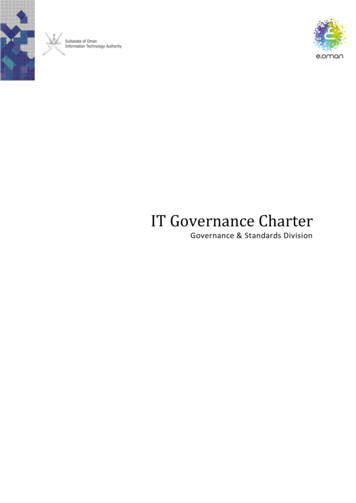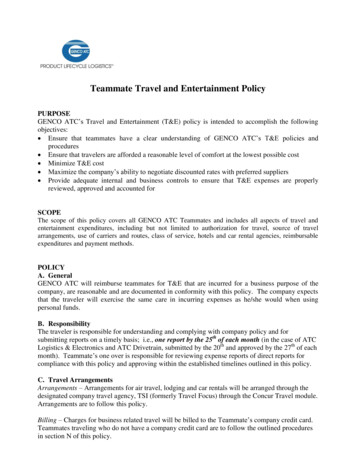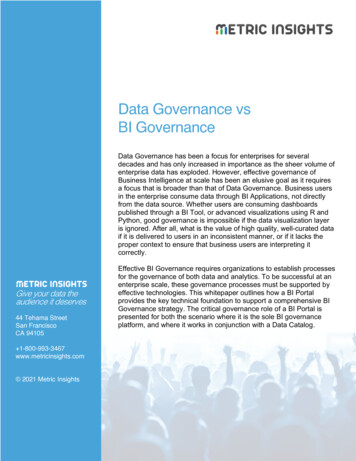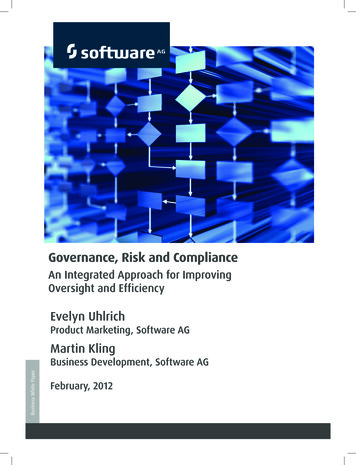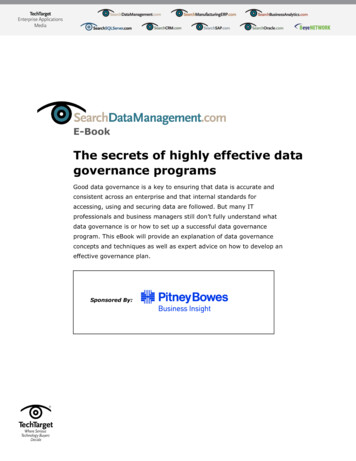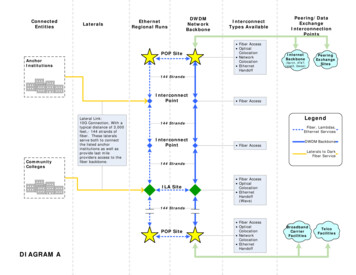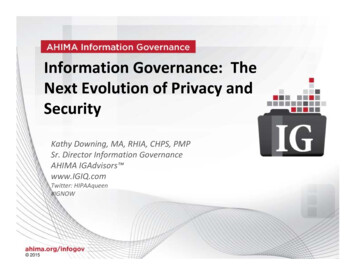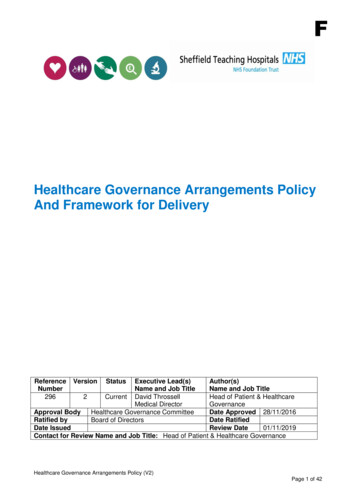
Transcription
FHealthcare Governance Arrangements PolicyAnd Framework for DeliveryReferenceNumber296VersionStatusExecutive Lead(s)Author(s)Name and Job TitleName and Job Title2Current David ThrossellHead of Patient & HealthcareMedical DirectorGovernanceApproval BodyDate Approved 28/11/2016Healthcare Governance CommitteeRatified byDate RatifiedBoard of DirectorsDate IssuedReview Date01/11/2019Contact for Review Name and Job Title: Head of Patient & Healthcare GovernanceHealthcare Governance Arrangements Policy (V2)Page 1 of 42
Associated Documentation:STHFT Quality Strategy 2012Introduction to Equality and Human Rights PaperTrust Policies:22 Management of Health and Safety at Work Policy26 Information Governance Policy43 Central and Local Induction Policy52 Risk Management Policy53 Incident Management Policy54 Mandatory and Job Specific Training Policy98 Concerns and Complaints Policy151 Major Incident Plan158 Code of Practice for Producing, Publishing and Managing Patient Information Materials160 Patient Record Keeping Policy171 Safeguarding Vulnerable Adults Policy172 Safeguarding Children Policy256 Policy for Authorising Staff to Use Medical Equipment and Medical Devices269 Infection Prevention and Control Programme273 Healthcare Records Policy275 Clinical Audit Policy276 Management of Re-useable Medical Equipment PolicyExternal Documentation:MONITOR : Well led framework for governance reviews: Guidance from NHS foundation trusts –updates April 2015Legal Framework:None notedVersion HistoryVersionOwner’s Name:Date IssuedBrief Summary of amendments104/04/2013Pauline Watson1.106/06/2013New Trust Controlled Document whichreplaces the Statement on HealthcareGovernance Arrangement forDirectorates and Corporate DepartmentsOctober 2009Clarification of section 3.3Updated to reflect current Trusthealthcare governance arrangementsHead of Patient andHealthcareGovernance2TBCPauline WatsonDocument ImprintCopyright Sheffield Teaching Hospitals NHS Foundation Trust 2017: All Rights ReservedRe-use of all or any part of this document is governed by copyright and the“Re-use of Public Sector Information Regulations 2005. SI 2005 No 1515.Information on re-use can be obtained from:The Department for Information Governance & Caldicott Support, Sheffield Teaching Hospitals.Tel: 0114 226 5151. E-mail: infogov@sth.nhs.ukHealthcare Governance Arrangements Policy (V2)Page 2 of 42
Executive SummaryHealthcare governance arrangements policyDocument Objectives:This document describes the local healthcare governance structures,systems and processes that clinical directorates and corporatedepartments need to have in place. This will ensure consistency andenable local governance arrangements to meet Trust requirements.Group/PersonsConsulted:Specialist corporate governance leads e.g.Patient Safety Manager;Clinical DirectorsNurse Directors and Deputy Nurse Directors;Operations Director;Corporate Departmental Heads;Directorate Healthcare Governance Groups; andSafety and Risk Management Board.MonitoringArrangements andIndicators:Self-assessment by Directorate/Department review as part of theannual business planning processHealthcare Governance Risk Management Audit ProgrammeTraining Implications:Training is specified for each specialist role. Detail is provided in thetraining needs analyses that can be accessed through the Mandatoryand Job Specific Policy.Equality ImpactAssessment:An Equality Impact Assessment has been completed (see appendix8). This policy has the potential to improve equality by strengtheninggovernance arrangementsResource implications:This document formalises the resource requirements specified in theStatement on Healthcare Governance Arrangements for Directoratesand Corporate Departments October 2009.Intended Recipients:Who should: be aware of thedocument and whereto access itExecutive Directors, Clinical Directors, Nurse Directors, OperationsDirector. understand thedocumentMedical Healthcare Governance Leads and Heads of CorporateDepartments have a good workingknowledge of thedocumentPatient and Healthcare Governance Department, CorporateSpecialist Governance Leads, Directorate/Department Non-medicalGovernance Leads, Directorate/Department Governance SpecialistLeadsHealthcare Governance Arrangements Policy (V2)Page 3 of 42
ContentsPage1. Introduction and Scope52. Purpose53. Central Accountabilities and Responsibilities64. Clinical Directorate Accountabilities and Responsibilities65. Corporate Department Accountabilities and Responsibilities76. Specialist Lead Roles87. Directorate/Department Governance Groups and Meetings98. Leadership, Communication and Staff Involvement99. Audit of Compliance with this Document10Appendix 1. Healthcare Governance Specialist Lead RolesAppendix 2. Clinical Directorate Governance Group Model Terms of ReferenceAppendix 3. Clinical Directorate Governance Meetings Model AgendaAppendix 4. Corporate Department Governance Meetings Model AgendaAppendix 5. Lines of Governance AccountabilityAppendix 6. Healthcare Governance Arrangements – Self-Assessment Process(Business Plan Template)Appendix 7. Equality Impact AssessmentHealthcare Governance Arrangements Policy (V2)Page 4 of 42
1. INTRODUCTION AND SCOPE1.1The Trust’s primary aim is to ensure that patients receive the highest possible qualityof care. Robust governance systems enable the Trust to examine the servicesprovided in clinical directorates and corporate departments to ensure that services arecapable of meeting the Trust’s primary aim consistently and where necessary identifyand implement changes to bring about improvement.1.2Good governance is having structures and processes to lead, direct and control thequality of service. This includes identifying and minimising risk, ensuring that therequired standards are achieved, investigating and responding to sub-standardperformance, driving quality improvement and sharing best practice.1.3Healthcare governance is concerned with matters that impact upon the quality ofservice provided to patients and their carers. This is a wide ranging theme includingsubjects as diverse as recruitment of suitable staff, patient experience, provision of anappropriate environment, safety of clinical practice, and confidentiality of records. Keyfunctions are: Occupational Safety;Patient Safety;Risk;Business Continuity and Emergency Planning;Infection Prevention and Control;Medical Equipment;Safeguarding;Equality and Human Rights;Complaints ;Patient Experience;Clinical Effectiveness/Audit ;Research;Information for Patients;Clinical Records;Clinical Informatics; andMandatory Training.2. PURPOSE2.1This document describes the local healthcare governance structures, systems andprocesses that clinical directorates and corporate departments require. This willensure consistency across the organisation and enable local governancearrangements to meet statutory, regulatory, and Trust requirements.2.2Governance requirements vary from one directorate/department to another dependingon the nature of their work and the type of risk involved. Therefore this documentprovides a framework for directorates and departments to refer to when makingappropriate local governance arrangements.2.3This framework describes the roles and responsibilities to be included withindirectorate and department structures. Also described are the communicationmechanisms for connecting directorate/department governance staff with corporatespecialists, central governance departments and Trust-wide groups. Directorates/departments are required to have formal arrangements in place for completing andrecording their own governance activity, this is usually delivered through the work oflocal governance groups. This framework includes model terms of reference andagendas for local governance groups.Healthcare Governance Arrangements Policy (V2)Page 5 of 42
3. CENTRAL ACCOUNTABILITIES AND RESPONSIBILITIES3.1Board of DirectorsThe Board of Directors has overall accountability for ensuring satisfactory healthcaregovernance across the Trust. These duties are normally conducted through the workof the Healthcare Governance Committee (HCGC).3.2Healthcare Governance CommitteeThe Healthcare Governance Committee sets the strategic direction for healthcaregovernance and risk management on behalf of the Board. The Committee has anannual work plan for receiving reports, minutes and briefings from sub-committees,groups and specialist leads who have a healthcare governance remit. The work planincludes a quarterly report on Directorate Healthcare Governance Performance.3.3Trust Executive GroupMembers of the Trust Executive Group (TEG) have collective responsibility forensuring the delivery of effective quality and governance processes across the Trust.TEG members are also individually accountable to the Chief Executive Officer forensuring safe and appropriate healthcare governance arrangements are in placewithin their own directorate. The Executive Director with lead responsibility forHealthcare Governance is the Medical Director. An assessment of local governancearrangements and compliance with CQC standards is included in the annual businessplanning process.3.4Medical DirectorThe Medical Director is responsible for ensuring healthcare governancearrangements are operating satisfactorily across the Trust. These arrangements aremonitored by the Patient and Healthcare Governance Department.3.5Patient & Healthcare Governance DepartmentThe Patient and Healthcare Governance Department is a central departmentresponsible for the ongoing development of Trust governance arrangements to raisethe quality of service and keep pace with changing healthcare legislation and othernational requirements. This role includes monitoring the quality of local directoratearrangements.3.6Trust-wide Healthcare Governance GroupsSpecialist Trust-wide boards, committees and groups provide leadership, guidanceand co-ordination for their area of expertise. Examples include the Safety and RiskManagement Board, the Infection Prevention and Control Committee, the PatientExperience Committee and the Healthcare Governance Operational Group. Furtherinformation about the roles and responsibilities of each group can be accessedthrough Appendix 1.4. CLINICAL DIRECTORATE RESPONSIBILITIES AND ACCOUNTABILITES4.1The Directorate Executive TeamThe Clinical Director, Nurse Director and Operations Director are required to workclosely together as an effective team to ensure good governance is an integral part ofdirectorate business and serious matters are escalated appropriately.Healthcare Governance Arrangements Policy (V2)Page 6 of 42
4.2Clinical DirectorsClinical Directors provide leadership to improve the quality of their services. Their roleincludes accountability for their directorate healthcare governance arrangements. TheClinical Director requires assurance that local arrangements meet the requirementslaid out within this framework and that the directorate executive team is kept informedof governance developments and concerns. The Clinical Director should be assuredthat local governance processes are appropriately managed, contribute to qualityimprovement and are reviewed as part of the business planning process.4.3Medical Governance LeadsThe clinical directorates that employ medical staff need to have arrangements formedical governance leadership. The Clinical Director may fulfil this role personally orthey may formally delegate responsibility to one or more Medical Governance Leads.The role of Medical Governance Lead involves proactive leadership of the directorategovernance group, engaging with fellow consultants to raise standards, and use ofkey governance data to underpin safety and quality improvement.4.4Nurse Directors and Deputy Nurse DirectorsClinical care groups that employ nursing staff have Nurse Directors who provide localnursing leadership for healthcare governance, reporting to the Clinical Directors.Their role includes active engagement with other Nurse Directors and OperationsDirectors. Much of the operational management of healthcare governance isdelegated to Deputy Nurse Directors where these roles are included in the CareGroup’s structure. Deputy Nurse Directors report to the Nurse Directors and ensurethe co-ordination and delivery of local healthcare governance activity e.g. riskmanagement, audits and training.Operations Director are required to ensure they are up to date with healthcaregovernance goals and concerns and take these into account when working with theClinical Directors and Nurse Directors to ensure high standards of clinical care withinavailable resources. Operation Directors lead on the development of contractualquality measures ensuring accuracy of data, staff engagement, monitoring bydirectorate governance groups and that action is taken to maintain and improvequality. Operations Directors also provide local healthcare governance leadership foradministration and clerical staff.4.5Clinical Directorate Healthcare Governance Leads and Specialist Lead RolesEach clinical directorate has an identified lead for co-ordinating and completing localhealthcare governance activity.This role ensures comprehensive cover andintegration of the various governance functions e.g. incidents, complaints and risks.The most common arrangement is for clinical directorates within a care group to sharethe same governance lead as part of a small team which covers the relevant specialistlead roles. These roles and functions are summarised in Section 6 and described inAppendix 1.5. CORPORATE DEPARTMENT RESPONSIBILITIES AND ACCOUNTABILITIES5.1The Corporate Executive DirectoratesTrust Executive Directors each manage a number of corporate departments thatsupport the Trust’s primary aim of ensuring that patients receive the highest possiblequality of care. Each Trust Executive Director requires assurance that theirdepartments have arrangements in place which meet the requirements laid out withinthis framework relevant to the nature of their work and the type of risk involved. Themost common arrangement is for corporate departments within an executivedirectorate to have separate governance arrangements.Healthcare Governance Arrangements Policy (V2)Page 7 of 42
5.2Heads of Corporate DepartmentsThe amount of direct contact with patients varies from one corporate department toanother and this will influence the governance arrangements required to meet therequirements within this framework. Some requirements e.g. Health and Safety will becommon to all departments whereas others e.g. medical equipment management willonly be relevant to a few. Heads of corporate departments are accountable forensuring that their department has suitable arrangements in place including therelevant specialist governance roles described in Appendix 1. The Head ofDepartment should be kept informed of governance developments and concerns andbe assured that local governance processes are appropriately managed, contribute toquality improvement, are reviewed at least once a year, and that any serious mattersare escalated appropriately.5.3Corporate Department Healthcare Governance Leads and Specialist Lead RolesA designated lead is required to act as the healthcare governance lead for corporatedepartments within each executive directorate. Heads of Department may fulfil thisrole personally or may delegate the responsibilities to one or more members of staff.The role involves being the first point of contact for governance matters; co-ordinating,completing and reporting on local healthcare governance activity; and ensuring therelevant specialist lead roles are fulfilled e.g. incident reporting, risk assessment andmandatory training. These roles and functions are summarised in Section 6 anddescribed in Appendix 1.6. SPECIALIST LEAD ROLES6.1Clinical Directors and Corporate Heads of Department must put in place robustgovernance arrangements. This includes allocating and managing relevant specialistlead roles. The amount of time required to fulfil these specialist roles variesconsiderably, in some areas the duties can all be performed by one person whereasother areas will require a number of designated persons.6.2An outline of each specialist role is provided in Appendix 1. The roles are: 6.3Occupational Safety;Patient Safety;Risk;Business Continuity and Emergency Planning;Infection Prevention and ControlMedical Equipment;Safeguarding;Equality and Diversity;Complaints;Patient Experience;Clinical Effectiveness/Audit Lead;Research;Information for Patients;Clinical Records;Clinical Informatics; andMandatory Training.Clinical Directors and Corporate Heads of Department require assurance thatspecialist roles are reflected in job descriptions, job plans, appraisals and personaldevelopment plans.Healthcare Governance Arrangements Policy (V2)Page 8 of 42
6.4Individuals with specialist lead responsibilities are required to develop two-waycommunication links with corporate departments and be members of relevant Trustwide governance groups. Some posts involve direct contact with external agenciese.g. involvement in external agency visits, inspections and audits and reporting ofincidents.7. DIRECTORATE/DEPARTMENT GOVERNANCE GROUPS AND MEETINGS7.1Healthcare governance meetings are scheduled within each area and scheduledmonthly. These report into the directorate executive team meetings. Appendix 2provides model terms of reference for a healthcare governance group; Appendix 3provides a model agenda for a healthcare governance meeting. These documentsprovide guidance for clinical directorates to adapt to suit their own circumstances.The healthcare governance groups keep appropriate records of their governanceactivity including formal reports and minutes.7.2Clinical directorates may also dedicate meetings for topics such as research,morbidity and mortality and clinical audit. Key points from these meetings should beincluded in the directorate healthcare governance group meetings to ensure that theMedical Governance Lead has oversight of the full governance agenda.7.3It may also be relevant for a small number of corporate departments to have monthlystand-alone healthcare governance group meetings. However, the most commonarrangement is for corporate departments to discuss governance performance eitherduring general departmental meetings, or to have focused meetings between theHead of Department and their governance lead/specialist(s). Corporate departmentsare required to discuss local healthcare governance matters at least four times a yearand to formally minute their discussions. Appendix 4 provides a model agenda for acorporate department healthcare governance meeting. This document providesguidance for Corporate Heads of Department to adapt to suit their own circumstances.7.4Healthcare governance meetings in both clinical directorates and corporatedepartments regularly monitor their own governance performance e.g. incident rateand risk register. Directorate/department governance meetings review information atleast four times a year on incidents, complaints, claims and inquests which discussthe trends and action required.7.5Directorate/department staff with specialist governance roles provide the link betweentheir local governance meetings and the relevant corporate specialist lead, centraldepartment and Trust-wide specialist group. The directorate/department specialistleads provide their local governance meetings with a verbal or written update onperformance determined by the directorate / department, but no less than four times ayear and kept informed about any significant issues and developments.7.6The directorate/department governance groups/meetings investigate sub-standardgovernance performance. The groups need to escalate the issues and/or take directaction. This is documented and reported using the relevant procedures e.g. incidentmanagement, risk management, or line-management.8. LEADERSHIP, COMMUNICATION AND STAFF INVOLVEMENT8.1Appendix 5 provides a broad outline of the lines of governance accountability.Clinical Directorates and Corporate Departments are expected to communicate theirlocal governance arrangements and lines of responsibility to their own staff, corporatespecialist leads, central governance departments and Trust-wide specialistgovernance committees.Healthcare Governance Arrangements Policy (V2)Page 9 of 42
8.2Local two-way communication arrangements should be in place to engage staff withthe healthcare governance agenda and enable them to understand how their effortscan improve patient safety, patient experience and quality of service. Staff arerequired to be aware of the local healthcare governance goals, achievements andissues and be able to see the relevance of the governance tasks they are asked tocomplete.8.3Clinical directorates and corporate departments are required to ensure that their staffunderstand their personal responsibilities for healthcare governance including theprocedures they need to follow and how to obtain further information and assistance.Induction, mandatory training, appraisal, supervision and education are criticalaspects of an effective governance structure. Each clinical directorate and corporatedepartment has a mandatory training plan and the directorate or department can uselocal information from a range of sources e.g. patient feedback to determine keymessages to incorporate into locally-delivered induction and training.9. AUDIT OF COMPLIANCE WITH THIS DOCUMENT9.1Clinical directorate and corporate department governance arrangements aremonitored through the Safety and Risk Management Board co-ordinated by thePatient and Healthcare Governance Department each year. This includes: Terms of reference are submitted to the Safety and Risk Management Boardannually for formal ratification from each care group/ division / specialty asappropriate. A formal update provided by each governance lead will be submitted on a rollingprogramme in accordance with the Safety and Risk Management Board workplace.Healthcare Governance Arrangements Policy (V2)Page 10 of 42
APPENDIX 1HEALTHCARE GOVERNANCE SPECIALIST LEAD ROLES1. Healthcare Governance Lead RoleKey Duties First point of contact for directorate/department staff, corporate specialists, centralgovernance departments, and Trust-wide specialist committees for governancecommunications covering multiple specialist roles or when the designated lead is absent. Ensure that healthcare governance communication is locally disseminated to relevantstaff, and that they are consulted about changes to governance systems and documents. Ensure that serious directorate or department issues are rapidly brought to the attentionof the relevant directorate/department lead, corporate lead/central department, and to anyrelevant colleagues in other directorates, departments or committees. Receive guidance from corporate specialists and central governance departments aboutlegislation and national standards, consider how processes could be changed to improvecompliance and quality, and recommend changes to systems, policies and protocols. Ensure that agreed changes to governance systems, policies and protocols areimplemented across the directorate/department and any issues are fed back. Participatein surveys, audits and inspections to test local governance processes and provideevidence of compliance with standards when required. Ensure that local systems are in place to review and update clinical guidelines andgovernance protocols produced by the directorate/department. Support and advise the directorate/department governance specialist leads; co-ordinateand integrate their work e.g. where there connections between an incident and acomplaint/claim/inquest/safeguarding case; and ensure that any associated riskassessment is up-to-date. Support and advise the Medical Governance Lead/Corporate Heads of Department,ensure relevant information and data is reported to the directorate/departmentgovernance group and complete agreed actions. Support local service improvement and quality improvement projects and applyappropriate governance processes e.g. risk assessment when required.Expectations for Participation in Trust-wide Governance MeetingsSee Terms of Reference for Healthcare Governance Operational Group and Termsof Reference for Safety and Risk Management BoardExpectations for Communication with External AgenciesNonePerson Specification – Essential Criteria – Knowledge, Skills and ExperiencePost holders will need prior experience of healthcare governance activity and goodunderstanding of the range of work carried out in their directorate.Mandatory TrainingSee Training Needs Analysis for Risk Management/Health and Safety including Incident,Complaints, Claims Reporting and Investigation, Inoculation Incident and Falls Reduction.Additional TrainingUnderstanding of the Healthcare Governance Arrangements Policy, Management ofHealth and Safety at Work Policy; Risk Management Policy; and Incident ManagementPolicy.Healthcare Governance Arrangements Policy (V2)Page 11 of 42
2. Occupational Safety LeadKey Duties Receive and respond to safety alerts within the specified timescales. N.B. this role maybe allocated to the Patient Safety Lead instead. Ensure risk assessments are completed in each area of the directorate/department,action plans are completed, and risks are reviewed at least once a year. N.B. this rolemay be allocated to the Risk Lead. Report, record and manage all incidents, including those incidents that require reportingunder the Reporting of Injuries, Diseases and Dangerous Occurrences Regulations. Inspect areas within jurisdiction regularly and undertake any environmental monitoringand health surveillance that is relevant to the local area and type of work. Ensure appropriate assessments relating to the Control of Substances Hazardous toHealth (CoSHH) are completed, identify, introduce and monitor control measures. N.B.this role may be allocated to the Risk Lead. Develop and implement local processes for specific issues relevant to the directorate/department e.g. Lone Working. Provide directorate/department staff with information, instruction and training on mattersrelated to health and safety, including on induction and through mandatory trainingupdates, record training provided. Produce and implement action plans where these are necessary to improve health andsafety performance. Report information relating to the numbers, types and severity of incidents involving staff,students and visitors to the directorate/department governance group.Expectations for Participation in Trust-wide Governance MeetingsSee Terms of Reference for Safety and Risk Management BoardExpectations for Communication with External AgenciesRIDDOR reports to HSEPerson Specification – Essential Criteria – Knowledge, Skills and ExperienceThe appropriate qualification for each post should be agreed between thedirectorate/department, the Occupational Safety Manager and the Core Learning Lead.The minimum Health and Safety qualification required to fulfil this role will be at certificatelevel but for some areas diploma level may be required dependent on the nature of thedirectorate/department.Post holders will need prior experience in the same type of workplace and goodunderstanding of work activity in their directorate.Mandatory TrainingSee Training Needs Analysis for Risk Management/Health and Safety including Incident,Complaints, Claims Reporting and Investigation, Inoculation Incident and Falls Reduction.Additional TrainingUnderstanding of the Management of Health and Safety at Work Policy; the RiskManagement Policy; and the Incident Management Policy.Healthcare Governance Arrangements Policy (V2)Page 12 of 42
3. Patient Safety LeadKey Duties Drive forward patient safety initiatives Receive and respond to safety alerts within the specified timescales. N.B. this role maybe allocated to the Occupational Safety Lead instead. Investigate incidents involving patient safety issues using Root Causes Analysistechniques. Ensure the directorate/department considers the risks to patient safety during serviceplanning. Ensure that any risks identified through patient safety work are assessed and, whereappropriate, entered onto the Trust’s Risk Register. These risks should be reviewed andmanaged in accordance with the MSK Policy. Produce and implement action plans to address risks and following any significant patientsafety incidents. Ensure that morbidity and mortality statistics and individual cases are discussed indirectorate meetings and that key findings and actions are brought to the attention of thedirectorate healthcare governance group. Report information relating to the numbers, types and severity of incidents involvingpatients to the directorate/department governance group. Ensure that the directorate/department manage incidents within the Trust specifiedtimeframes and comply with the Duty of Candour requairements.Expectations for Participation in Trust-wide Governance MeetingsSee Terms of Reference for Safety and Risk Management BoardExpectations for Communication with External AgenciesNonePerson Specification – Essential Criteria – Knowledge, Skills and ExperiencePost holders will need prior experience in the same type of workplace and goodunderstanding of patient care in their directorate.Mandatory TrainingSee Training Needs Analysis for Risk Management/Health and Safety including Incident,Complaints, Claims Reporting and Investigation, Inoculation Incident and Falls Reduction.Additional TrainingUnderstanding of the Risk Management Policy and the Incident Management Policy. Rootcause analysis techniques.Healthcare Governance Arrangements Policy (V2)Page 13 of 42
4. Risk LeadKey Duties Ensure risk assessments are completed and reviewed in each area of thedirectorate/department and entered onto the Trust’s Risk Register where appropriate. Ensure that local managers imple
TEG members are also individually accountable to the Chief Executive Officer for ensuring safe and appropriate healthcare governance arrangements are in place within their own directorate. The Executive Director with lead responsibility for Healthcare Governance is the Medical Director. An assessment of local governance
